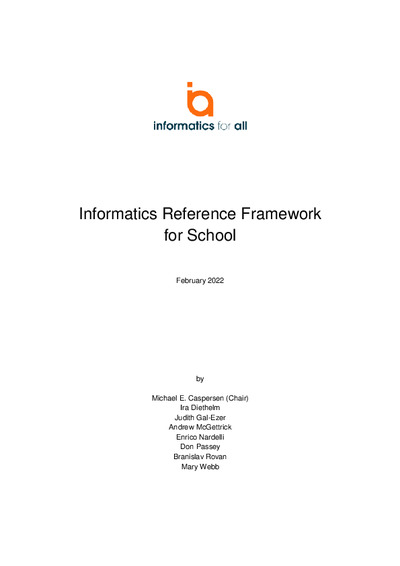Informatics Reference Framework for SchoolMichael E. Caspersen, Ira Diethelm, Judith Gal-Ezer, Andrew D. McGettrick, Enrico Nardelli, Donald Passey, Branislav Rovan, Mary Webb
Publikationsdatum:
|
 |
 Diese Seite wurde seit mehr als 7 Monaten inhaltlich nicht mehr aktualisiert.
Unter Umständen ist sie nicht mehr aktuell.
Diese Seite wurde seit mehr als 7 Monaten inhaltlich nicht mehr aktualisiert.
Unter Umständen ist sie nicht mehr aktuell.
 Zusammenfassungen
Zusammenfassungen
 The contribution that informatics has made since the last century has fuelled innovative and
significant technological advances and vice versa. It makes fundamental contributions to
current economic, educational, industrial and social development.
The contribution that informatics has made since the last century has fuelled innovative and
significant technological advances and vice versa. It makes fundamental contributions to
current economic, educational, industrial and social development.Informatics importantly has the capacity to support and augment human reasoning and potential. Education systems have a responsibility to recognise this and to ensure that young people are equipped to be able to drive forward, judge innovation and take part in the development of a just and fair society.
To properly embrace this development by society in general, informatics has to be seen as an essential aspect of the education of all pupils. The present report, which outlines an informatics reference framework for all young people, bears that in mind. It is intended to offer high-level guidance that may be used by, and indeed stimulate, curriculum designers to review their focus and approach to the subject of informatics.
Following the introductory sections, the heart of the reference framework is described in section 4. A set of aims and objectives for informatics education for all young people is provided in section 4.2 followed by a set of core concepts and an accompanying brief description of these in Table 1 of section 4.3; this conveys a robust structure and a general architecture, which captures an essential view of informatics as a discipline in general education. To complement the general architecture, a contemporary and outward facing view of informatics is offered in section 4.4; this includes discussion of modern developments that relate to topics such as data science and artificial intelligence, as well as attention to related ethical concerns.
Annex A.1 presents a brief description of informatics as a discipline. Annex A.2 presents a limited number of examples of how high-level learning outcomes could be described in a concrete curriculum at three levels that reflect indicators of outcomes after primary, lower secondary and upper secondary education.
 Dieses Positionspapier erwähnt ...
Dieses Positionspapier erwähnt ...
 Dieses Positionspapier erwähnt vermutlich nicht ...
Dieses Positionspapier erwähnt vermutlich nicht ... 
 Nicht erwähnte Begriffe | blockbasierte Programmierumgebungen, Digitalisierung, Informatikunterricht in der Schule, Kinder, LehrerIn, Lehrplan 21, Schweiz, Unterricht |
 Tagcloud
Tagcloud
 Zitationsgraph
Zitationsgraph
 Zitationsgraph (Beta-Test mit vis.js)
Zitationsgraph (Beta-Test mit vis.js)
 6 Erwähnungen
6 Erwähnungen 
- Digitalisierung im Bildungssystem - Handlungsempfehlungen von der Kita bis zur Hochschule - Gutachten der Ständigen Wissenschaftlichen Kommission der Kultusministerkonferenz (SWK) (SWK Ständige Wissenschaftliche Kommission der KMK) (2022)


- WiPSCE '22 - The 17th Workshop in Primary and Secondary Computing Education, Morschach, Switzerland, 31 October 2022 - 2 November 2022 (Mareen Grillenberger, Marc Berges) (2022)

- Informatikunterricht: Deutschland abgehängt in Europa - Eine Vergleichsstudie zu Informatik an Schulen in Europa (Felix Suessenbach, Eike Schröder, Mathias Winde, Stifterverband) (2023)


- Past, Present and Future of Computing Education Research (Mikko Apiola, Sonsoles López-Pernas, Mohammed Saqr) (2023)


- Computing Education Research in Baltic Countries (Valentina Dagienė, Mart Laanpere, Juris Borzovs)


- Computing Education Research in Baltic Countries (Valentina Dagienė, Mart Laanpere, Juris Borzovs)
- WIPSCE '23 - The 18th WiPSCE Conference on Primary and Secondary Computing Education Research (Sue Sentance, Mareen Grillenberger) (2023)
- Developing a Computer Science Content Knowledge Test for 10th Grade Students (Tobias Bahr) (2023)


- Developing a Computer Science Content Knowledge Test for 10th Grade Students (Tobias Bahr) (2023)
- Aufbau fachwissenschaftlicher und fachdidaktischer Informatikkompetenzen bei Grundschullehramtsstudierenden (Christin Nenner) (2024)


 Volltext dieses Dokuments
Volltext dieses Dokuments
 |  Informatics Reference Framework for School: Artikel als Volltext ( Informatics Reference Framework for School: Artikel als Volltext ( : :  , 257 kByte; , 257 kByte;  : :  ) ) |
 Anderswo suchen
Anderswo suchen 
 Beat und dieses Positionspapier
Beat und dieses Positionspapier
Beat hat Dieses Positionspapier während seiner Zeit am Institut für Medien und Schule (IMS) ins Biblionetz aufgenommen. Beat besitzt kein physisches, aber ein digitales Exemplar. Eine digitale Version ist auf dem Internet verfügbar (s.o.). Es gibt bisher nur wenige Objekte im Biblionetz, die dieses Werk zitieren.









 Algorithmus
Algorithmus Innovation
Innovation Kreativität
Kreativität Künstliche Intelligenz (KI / AI)
Künstliche Intelligenz (KI / AI) Lernen
Lernen machine learning
machine learning Privatsphäre
Privatsphäre Programmieren
Programmieren Schule
Schule Wissenschaft
Wissenschaft WWW (World Wide Web)
WWW (World Wide Web) Biblionetz-History
Biblionetz-History